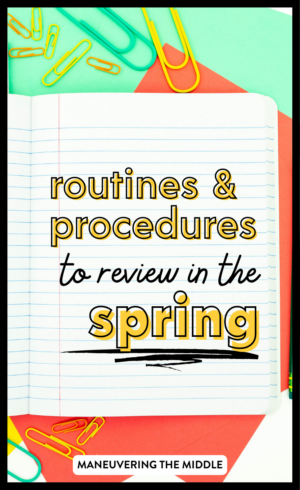January is here, which means the spring semester has started! After a long winter break, students need to be refreshed on how your classroom runs, so let’s talk about teaching (or reteaching) those beloved routines and procedures.

Is this really necessary?
You know your students and what is happening in your classroom best. For me, it was always a yes. I didn’t go into nearly as much detail as I would have in August, but I did spend a little time everyday reviewing a routine or procedure the first week back.
Consider how December went and make the decision based on how well your students were modeling those procedures before winter break. Even if your students would earn an A+ for your class routines, a refresher after 2+ weeks out of the classroom won’t hurt. It also shows students that it is still important enough to you to repeat.
We spend time reviewing math content, so why would we not spend time reviewing classroom routines and procedures?
Which Routines and Procedures need reviewing?
Going over every single routine and procedure might overdo it, so what are the parameters for which routines and procedures to go back over?
- Do you want to introduce a new routine and procedure? Start here. Perhaps, you want to introduce a new way to earn points for a class incentive. Or maybe your Chromecart has been a mess, and you have a new method for organization that will be a community effort.
- Is there a procedure that you noticed starting to slip back in December? Are students taking too long getting their materials out? Are students not pushing their chairs back in when dismissed?
- What routines are the most vital to the day-to-day functioning of your classroom? Review them! Being proactive can prevent future encounters where you are having to correct students.
Explain, Model, Practice + Fun Activity Idea
This method for reviewing routines and procedures (or sharing them for the first time) is perfect for the spring semester.
Explain – This is exactly what it sounds like. Tell your students in detail what the procedure should look and sound like. You can present this information via slidedeck or in note format.
Model – This is how you get your students involved! *Fun activity alert* Grab a group of students. Four or so are going to model the routine perfectly, and one is going to be your non-example. Secretly assign your model students and the non-example. The students + you (the teacher) complete the routine as a skit. Let some hilarity ensue! Then have the rest of the class discuss what was correct and what wasn’t via turn and talk or group discussion.
Practice – Now it is time to practice with everyone! Depending on the routine, you may only have to do this once. Praise the students who are doing a great job.
This activity can take as little as 10-20 minutes, so there is still time to include math practice too. Complete this activity once a day until you have covered each routine you want to review.
Top 3 Routines and Procedures that Frequently Needed Review
- Classroom Entry – This topped my list every year. My classroom entry set the tone for the entire class period, so it was vital for it to be seamless. Silent, straight to their desks, materials out, and starting on the bell ringer by the time the bell rang. This was aided by my class posters.

- Group Work Expectations – We reviewed what being on task would look and sound like. In addition, we reviewed what students needed to do if they were stuck and needed help.
- Attention Getter – This expectation would start softening over the course of the Fall semester. It was a good reminder for myself that I needed to wait until all students were silent and looking at me before giving directions.
What classroom routines and procedures will you be reviewing this Spring semester?
P.S. Want more on routines and procedures?
- 20 Must Teach Middle School Routines and Procedures
- 15 More Middle School Routines and Procedures
- Routines and Procedures to Teach on the First Day
- Technology Routines and Procedures




